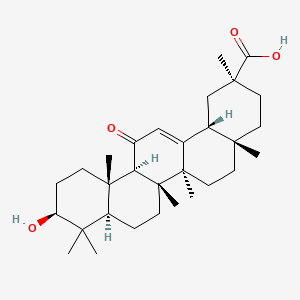| MeSH term | MeSH ID | Detail |
|---|---|---|
| Edema | D004487 | 152 associated lipids |
| Ear Diseases | D004427 | 7 associated lipids |
Glycyrrhetinic acid
Glycyrrhetinic acid is a lipid of Prenol Lipids (PR) class. Glycyrrhetinic acid is associated with abnormalities such as Congenital Abnormality, Cortisol 11-beta-ketoreductase deficiency, Hypertensive disease, Mineralocorticoid Excess Syndrome, Apparent and Syndrome. The involved functions are known as Signal, Muscle Contraction, Pressure- physical agent, Agent and Metabolic Inhibition. Glycyrrhetinic acid often locates in Protoplasm, Body tissue, Muscle, Connexon and Extracellular. The associated genes with Glycyrrhetinic acid are SLC33A1 gene, GJB1 gene, RNU1-1 gene, HADHA gene and RNU1-4 gene. The related lipids are Steroids, Saponin, Octanols, Heptanol and amyrin.
Cross Reference
Introduction
To understand associated biological information of Glycyrrhetinic acid, we collected biological information of abnormalities, associated pathways, cellular/molecular locations, biological functions, related genes/proteins, lipids and common seen animal/experimental models with organized paragraphs from literatures.
What diseases are associated with Glycyrrhetinic acid?
Glycyrrhetinic acid is suspected in Hypertensive disease, Kozlowski Celermajer Tink syndrome, Hypernatremia, Leishmaniasis, Visceral, Congenital Abnormality, Cortisol 11-beta-ketoreductase deficiency and other diseases in descending order of the highest number of associated sentences.
Related references are mostly published in these journals:
| Disease | Cross reference | Weighted score | Related literature |
|---|
Possible diseases from mapped MeSH terms on references
We collected disease MeSH terms mapped to the references associated with Glycyrrhetinic acid
PubChem Associated disorders and diseases
What pathways are associated with Glycyrrhetinic acid
There are no associated biomedical information in the current reference collection.
PubChem Biomolecular Interactions and Pathways
Link to PubChem Biomolecular Interactions and PathwaysWhat cellular locations are associated with Glycyrrhetinic acid?
Visualization in cellular structure
Associated locations are in red color. Not associated locations are in black.
Related references are published most in these journals:
| Location | Cross reference | Weighted score | Related literatures |
|---|
What functions are associated with Glycyrrhetinic acid?
Related references are published most in these journals:
| Function | Cross reference | Weighted score | Related literatures |
|---|
What lipids are associated with Glycyrrhetinic acid?
Related references are published most in these journals:
| Lipid concept | Cross reference | Weighted score | Related literatures |
|---|
What genes are associated with Glycyrrhetinic acid?
Related references are published most in these journals:
| Gene | Cross reference | Weighted score | Related literatures |
|---|
What common seen animal models are associated with Glycyrrhetinic acid?
There are no associated biomedical information in the current reference collection.
NCBI Entrez Crosslinks
All references with Glycyrrhetinic acid
Download all related citations| Authors | Title | Published | Journal | PubMed Link |
|---|---|---|---|---|
| Krähenbühl S et al. | Analysis and pharmacokinetics of glycyrrhizic acid and glycyrrhetinic acid in humans and experimental animals. | 1994 | Steroids | pmid:8191540 |
| Gomez-Sanchez EP et al. | The sheep kidney contains a novel unidirectional, high affinity NADP(+)-dependent 11 beta-hydroxysteroid dehydrogenase (11 beta-HSD-3). | 1997 | Steroids | pmid:9178432 |
| Latif SA et al. | Possible endogenous regulators of steroid inactivating enzymes and glucocorticoid-induced Na+ retention. | 1994 | Steroids | pmid:7940612 |
| Kasuya Y et al. | Validation of the plasma half-life of 11alpha-deuterium cortisol as a sensitive index for the analysis of human 11beta-HSD2 activity in vivo. | 2005 | Steroids | pmid:16005482 |
| Gomez-Sanchez EP et al. | 11 beta-hydroxysteroid dehydrogenases of the choriocarcinoma cell line JEG-3 and their inhibition by glycyrrhetinic acid and other natural substances. | 1996 | Steroids | pmid:8852827 |
| Armanini D et al. | Glycyrrhetinic acid, the active principle of licorice, can reduce the thickness of subcutaneous thigh fat through topical application. | 2005 | Steroids | pmid:15894038 |
| Kasuya Y et al. | Use of 11alpha-deuterium labeled cortisol as a tracer for assessing reduced 11beta-HSD2 activity in vivo following glycyrrhetinic acid ingestion in a human subject. | 2005 | Steroids | pmid:15631868 |
| Marandici A and Monder C | Inhibition by glycyrrhetinic acid of rat tissue 11 beta-hydroxysteroid dehydrogenase in vivo. | 1993 | Steroids | pmid:8493704 |
| Mattarello MJ et al. | Effect of licorice on PTH levels in healthy women. | 2006 | Steroids | pmid:16513152 |
| Latif SA et al. | The effects of the licorice derivative, glycyrrhetinic acid, on hepatic 3 alpha- and 3 beta-hydroxysteroid dehydrogenases and 5 alpha- and 5 beta-reductase pathways of metabolism of aldosterone in male rats. | 1990 | Steroids | pmid:2326827 |
